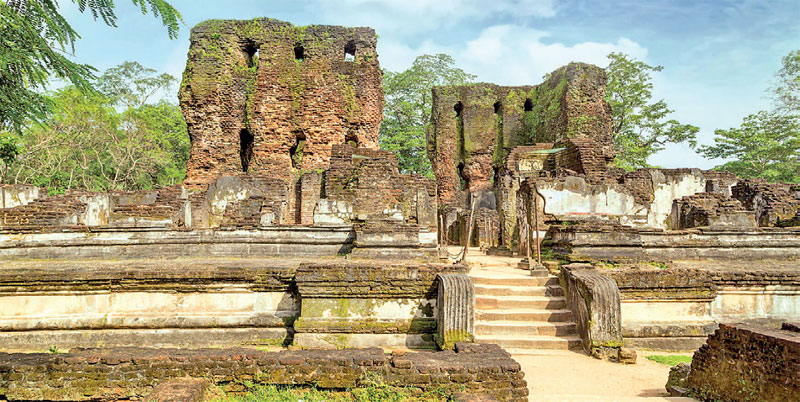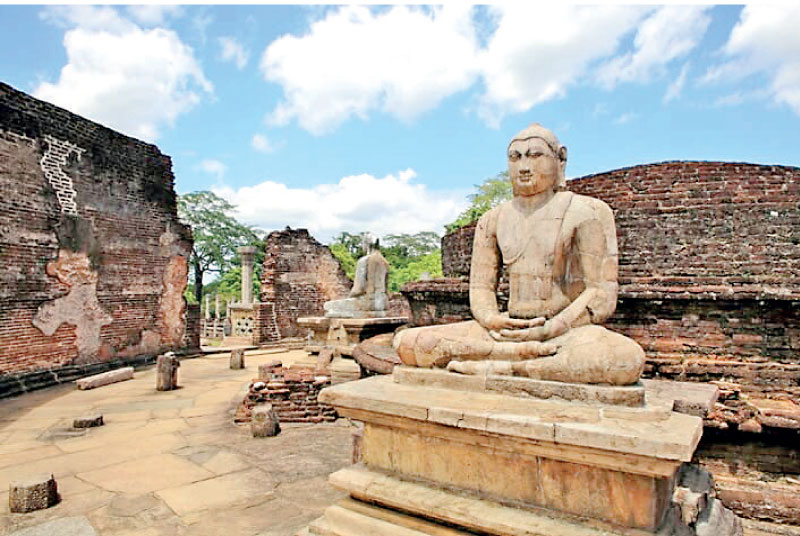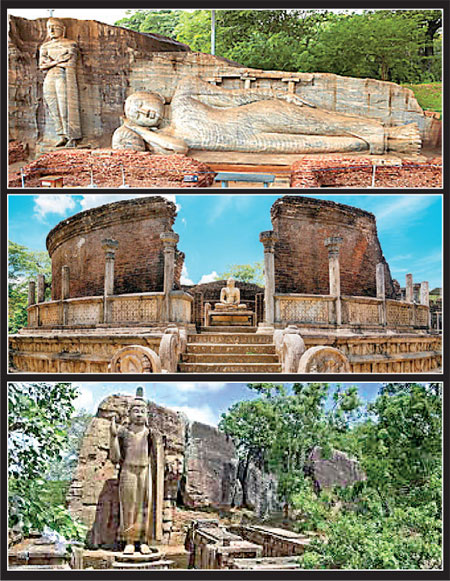Saturday May 18, 2024
Saturday May 18, 2024
Thursday, 10 August 2023 00:17 - - {{hitsCtrl.values.hits}}

By Nuzla Rizkiya
Boasting a rich history dating back thousands of years, evident in its ancient temples, royal palaces, and colonial architecture, exploring the ancient ruins in Sri Lanka is a fascinating journey that takes you back in time to a bygone era of grand civilizations and cultural marvels. Housing majestic cities like Anuradhapura, Polonnaruwa, and Sigiriya, the island showcases her genuine cultural and architectural brilliance making the process of delving into the wonders of Sri Lanka tourism like a realm where ancient history meets modern charm.

 Polonnaruwa - The Ancient Ruins
Polonnaruwa - The Ancient Ruins
Polonnaruwa, located in the North Central Province of Sri Lanka, is an ancient city steeped in rich history and culture. It served as the second capital of Sri Lanka after the fall of Anuradhapura and is now a UNESCO World Heritage Site. The city’s well-preserved ruins provide visitors with a glimpse into the grandeur of the past, showcasing the architectural and artistic achievements of ancient Sri Lanka. Exploring the ancient ruins of Polonnaruwa is like stepping back in time to a bygone era of glory and splendor.
The Royal Palace, located within the Citadel of Polonnaruwa, was once the residence of Sri Lanka’s ancient monarchs. Nearby the Royal Palace is the Audience Hall, with its finely carved stone columns and intricate detailing, showcasing the architectural prowess of the ancient craftsmen. The Quadrangle is a sacred area within the ancient city depicting an exquisite example of ancient Sinhalese architecture, featuring intricately carved stone pillars and moonstones. Located in the city is The Gal Vihara, also known as the Rock Temple, which is a collection of four stunning Buddha statues carved out of a single granite rock face. Rankot Vihara, a massive stupa, is one of the largest structures in Polonnaruwa offering a panoramic view of the surrounding ruins from its upper levels.
For visitors interested in learning more about the history and significance of the ancient ruins, the Archaeological Museum in Polonnaruwa provides a wealth of information. The museum houses a collection of artifacts and exhibits that shed light on the city’s past. What many do not want to miss is The Parakrama Samudra, an ancient irrigation reservoir built by King Parakramabahu I. The site is considered a testament to the advanced hydraulic engineering skills of the ancient Sri Lankans as the vast reservoir still serves as a vital water source for the region.

Anuradhapura - a Ceylonese political and religious capital that flourished for 1,300 years
A visit to Anuradhapura, the ancient capital of Sri Lanka, is an awe-inspiring journey back in time, where ancient ruins stand testament to a glorious past. This UNESCO World Heritage Site is a treasure trove of historical wonders, showcasing the architectural and cultural achievements of ancient Sri Lanka.
The Ruwanwelisaya Stupa located in the ancient capital is one of its most iconic landmarks.A massive stupa that stands as a symbol of peace and prosperity, the structure is adorned with intricate stone carvings and stills serves as an important pilgrimage site for Buddhists.
Located 5 minutes away is the Jetavanaramaya Stupa also, the largest stupa in Sri Lanka and one of the tallest structures of the ancient world. Its imposing presence and intricately designed stone works, the site stands as an example of the advanced engineering and architectural skills of the ancient Sri Lankans.
Considered to be the oldest stupa located in the island, the Thuparamaya Dagoba holds immense religious significance as it is believed to enshrine the collarbone relic of Lord Buddha, making it a revered place of worship for Buddhists. In line with this is the Abhayagiri Monastery-one of the largest monastic complexes in ancient Sri Lanka with its ruins which includes a stupa, image houses, and a massive ”Vatadage”, showcasing the grandeur and scale of the site. The Samadhi Buddha Statue is an exquisite masterpiece of ancient Sri Lankan art. Carved in stone, this serene Buddha statue represents the state of deep meditation and inner peace. Similarly, the Isurumuniya Temple is renowned for its rock carvings and tranquil setting. The temple complex houses a unique rock-cut image house and a beautiful pool known as the “Lovers’ Leap.”
Adding to this, Anuradhapura is dotted with intricately carved moonstones and guard stones at the entrances of religious buildings. These artistic stone carvings are a distinctive feature of Sri Lankan architecture.
Overall a visit to the ancient ruins of Anuradhapura is a captivating and enlightening experience. The historical significance, architectural splendor, and spiritual atmosphere of these ancient sites make the city a destination of profound cultural importance. Exploring these ruins offers a unique opportunity to connect with the rich history and heritage of Sri Lanka, leaving visitors with a deep appreciation for the enduring legacy of this ancient civilization.